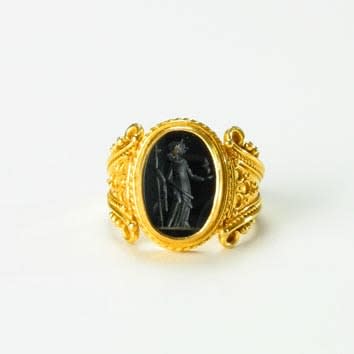Gold Ring Featuring a Classical Revival Onyx Intaglio of a Standing Deity, 18th Century CE
Onyx and Gold
FJ.6694
Further images
This Antique Seal Has Been Set in a Modern 21 Karat Gold Roman Style Rin The art of glyptics, or carving images on colored precious stones, is probably one of...
This Antique Seal Has Been Set in a Modern 21 Karat Gold Roman Style Rin
The art of glyptics, or carving images on colored precious stones, is probably one of the oldest known to humanity. Intaglios, gems with an incised design, were made as early as the fourth and third millennia B.C. in Mesopotamia and the Aegean Islands. They exhibit a virtuosity of execution that suggests an old and stable tradition rooted in the earliest centuries. The tools required for carving gems were simple: a wheel with a belt-drive and a set of drills. Abrasives were necessary since the minerals used were too hard for a metal edge. A special difficulty of engraving intaglios, aside from their miniature size, was that the master had to work with a mirror-image in mind.
The Classical Revival was a phenomenon that swept across Europe during the 18th and 19th Centuries. A new appreciation for antiquity and ancient art forms was fostered by discoveries in the nascent scientific field of archaeology. Perhaps the Classical Revival also reveals a latent longing towards the Arcadian lifestyles of yesterday abandoned as Europe became rapidly industrialized and increasingly urbanized. On this intaglio, the image of a standing female deity has been carved. This beautiful ring, modeled after Ancient Roman examples, emulates the enduring taste and style of the Classics and surely would have been just as admired in antiquity as it is today.
The art of glyptics, or carving images on colored precious stones, is probably one of the oldest known to humanity. Intaglios, gems with an incised design, were made as early as the fourth and third millennia B.C. in Mesopotamia and the Aegean Islands. They exhibit a virtuosity of execution that suggests an old and stable tradition rooted in the earliest centuries. The tools required for carving gems were simple: a wheel with a belt-drive and a set of drills. Abrasives were necessary since the minerals used were too hard for a metal edge. A special difficulty of engraving intaglios, aside from their miniature size, was that the master had to work with a mirror-image in mind.
The Classical Revival was a phenomenon that swept across Europe during the 18th and 19th Centuries. A new appreciation for antiquity and ancient art forms was fostered by discoveries in the nascent scientific field of archaeology. Perhaps the Classical Revival also reveals a latent longing towards the Arcadian lifestyles of yesterday abandoned as Europe became rapidly industrialized and increasingly urbanized. On this intaglio, the image of a standing female deity has been carved. This beautiful ring, modeled after Ancient Roman examples, emulates the enduring taste and style of the Classics and surely would have been just as admired in antiquity as it is today.





